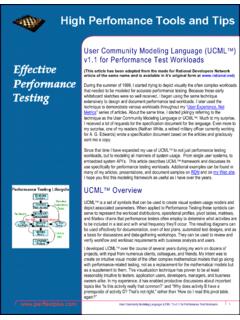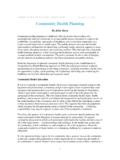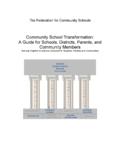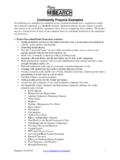Transcription of Key Performance Indicators for Knowledge …
1 Key Performance Indicators for Knowledge Management in a Community of Practice COPYRIGHT 2002 METIS PERSONAL USE OF THIS MATERIAL IS PERMITTED. HOWEVER, PERMISSION TO REPRINT/REPUBLISH THIS MATERIAL FOR ADVERTISING OR PROMOTIONAL PURPOSES OR FOR CREATING NEW COLLECTIVE WORKS FOR RESALE OR REDISTRIBUTION TO SERVERS OR LISTS, OR TO REUSE ANY COPYRIGHTED COMPONENT OF THIS WORK IN OTHER WORKS MUST BE OBTAINED FROM OR VIA TELEMATICA INSTITUUT ( ). Colophon Date : Dec. 31st, 2002 Version : 2 Change : 1 Project reference : TI reference : TI/RS/2002/142 URL : [URL] Access permissions : [Access permissions] Status : [Status] Editor : [Editor] Company : Tilburg University Author(s) : Aldo de Moor, Martin Smits Synopsis: This report is the deliverable of work package 7 of the METIS project, focusing on how Knowledge management processes can be measured and guided in communities of practice, a basic organizational unit in Knowledge -intensive organizations. The purpose of this report is to outline an approach to the definition and use of key Performance Indicators for Knowledge management in a community of practice.
2 Our intention was not to produce a comprehensive literature review, but to show how advanced theory and operational practice can be combined in a workable method. METIS/D V Preface The objectives of the Metis project for 2002 are (Metis Workplan April 24 2002): 1. Identify the targets that communities have and describe directions of development for communities given their targets 2. Develop a vision on how to manage Knowledge management 3. Analyse and model how Knowledge and information flow in supply chains 4. Generate an overview of business models that describes how Knowledge and information is bought and sold today 5. Identify problems in extracting Knowledge and information from communication and (technical) documentation 6. Experiment with improvements in finding Knowledge and information from heterogeneous collections. This report is the deliverable of work package 7 of the METIS project, focusing on how Knowledge management processes can be measured and guided in communities of practice, a basic organizational unit in Knowledge -intensive organizations.
3 The purpose of this report is to outline an approach to the definition and use of key Performance Indicators for Knowledge management in a community of practice. Our intention was not to produce a comprehensive literature review, but to show how advanced theory and operational practice can be combined in a workable method. Although we outline a theoretical framework in which this approach was embedded, we do not claim that this is necessarily the best approach from a theoretical point of view. Given, however, that the theories are well-known and applied and that this approach was accepted and partially implemented in an actual company, we do make the case that it is at least a plausible approach. The report should be read as a scenario that could be refined and extended in a follow-up case study in, for instance, Basell or Oc communities of practice. This report aims to contribute to the following main deliverables of METIS in 2002: Role and effectiveness of Chief Knowledge Officers Corporate learning Learning from customers Mapping Knowledge METIS/D VII Table of Contents 1 Introduction 1 2 Case: FundPartners 3 The Activities of FundPartners 3 Fund development 3 E-Business Portal 4 The Organization of FundPartners 4 The Operations of FundPartners 4 Fund development 4 E-Business Portal 5 Knowledge Development and Management in FundPartners 5 3 A Theoretical Framework 7 A Conceptualization of the Knowledge Creation Process 7 The SECI Model 7 Guidelines for Effective Knowledge Creation 11 Towards a Knowledge Strategy 16 Identification of Knowledge Creation Problems 16 Systems Thinking 17 Relating SECI to Systems Thinking 18 Learning Disabilities 18 Effective Knowledge Management.
4 Reducing the Disabilities 19 The Measurement of Knowledge Management Effectiveness 20 Measurement Methods for Intangible Resources 20 Applying the IC Method to FundPartners 21 Using the Measurements for Knowledge Creation Effectiveness 24 4 Discussion and Future Research 26 References 29 METIS/D 1 1 Introduction Communities of practice (CoP) are playing an increasingly important role in modern, Knowledge -intensive organizations. CoPs foster creative interactions amongst highly specialized experts and help to channel their efforts to where they are most needed. In this way, these communities are a key element in the learning organization. Being at the core of these companies, and Knowledge being one of their key assets, a structured process of Knowledge management is essential to assure the efficacy of CoPs in an organizational context. In order to ensure that Knowledge handling in a particular community is indeed effective and efficient, the Performance of its Knowledge management processes has to be measured.
5 To properly measure what is needed, key Performance Indicators can help to assess and guide the evolution of Knowledge management practices. Once a proper set of Indicators has been selected, best practices and benchmarks can be collected and systematically used to improve community operations. How to measure and use key Performance Indicators in Knowledge management in organizational communities of practice? Before we can address this question, we first need to clarify what we mean by organizational communities of practice. An extensive literature exists on the structure, operations, and evaluation of communities of practice ( Gongla and Rizuto, 2001; Fontaine et al., 2002). However, it often remains unclear exactly what and how to measure. Also, these communities are often examined in general terms of being productive, sociable, etc., but not from a Knowledge management perspective. CoP in an Organizational Context We are interested in the role that communities play in Knowledge management practices of the organization ( ).
6 The organization sets certain goals (at various levels: the organizations, teams, community, or individual level). The goals determine to what extent organizational processes, including Knowledge management processes, are effective. Indicators measure processes and products resulting from these processes in communities. Depending on the organization, communities play more or less important roles in meeting organizational goals. Organization!goalsCoPCoPCoPIndicatorsCoP 2 For example, in some traditional production organizations, communities are of little importance, whereas in the modern Knowledge organization, healthy communities are essential. There are different roles that CoPs can play in the organizational context. A community can operate on its own, interact with other communities within the organization, or with actors outside the organization. In this study, we look at the first, simplest case of an organization consisting of a single community. In future research, more complex cases can be analyzed.
7 Although a large body of literature exists on Knowledge management in general, so far not much specific theory has been formed about Knowledge management in communities of practice in an organizational context, let alone on the role that Performance Indicators play in them. On the other hand, in industry, some successful cases exist. In order to progress, state-of-the-art Knowledge management theory needs to be selected, combined, and applied. Such a theoretical lens should be used to examine successful case studies, resulting in useful and practical guidelines for Knowledge management procedures. The purpose of this paper is to construct such a lens, and to apply it to an interesting case. The results should provide a basic framework for follow-up research in an organizational context. The goal is not to come up with the ultimate approach, but to at least identify a viable starting point for future research into the measurement of Knowledge management effectivity in organizational communities of practice.
8 Important in our research approach is that it is not only driven by theoretical concerns, but also by intensive consultations with the practicioners in the organization. The approach was constructed by going through the theoretical-empirical cycle multiple times, all the time discussing relevance of theoretical proposals with company officials. We feel that this approach of selecting a combination of applicable theories and discussing their relevance with organizational representatives may help to better ground Knowledge management research in real-world practice. In this way, a more holistic and acceptable approach may be developed than by starting from one particular theoretical paradigm only, necessarily changing reality to match the framework. The theoretical constructs used were developed and applied in a typical case: FundPartners, a young company in which communities of practies play an important role In the next section, we introduce the FundPartners then describe a theoretical framework for effectivity measurement of Knowledge management ( creation) in organizational communities of practice, and apply this framework to the case.
9 The basis for this analysis is a case study done by Dijkstra (2002). We then make suggestions for future research and links to other projects within the METIS framework. METIS/D 3 2 Case: FundPartners FundPartners is a Dutch organization operating in the investment fund industry, especially in the development and exploitation of investment funds. Such funds are highly complex products, the development of which requires the selection of specialized roles and service providers, such as brokers (traders in investment objects), portfolio managers (selectors of investment objects to be sold or bought), various kinds of analysts, fund sponsors (regulator of whole fund), accountants, administrators, and custodians (processors of investment fund transactions). FundPartners acts as an intermediary in this web of roles ( ). Because of the increasingly required transparency of the investment fund industry, there is a need for more customized and specialized investment funds. The Position of FundPartners in the Value Chain The Activities of FundPartners FundPartners has two main activities: (1) fund development and (2) the e-business portal maintenance.
10 Fund development The core activity of the organization is the development of investment funds for distributors and institutional investors, by finding the best suppliers and service providers in the market. Distributors are organizations that offer funds to investors, like pension funds, insurance companies and banks. Suppliers are all parties, like the roles mentioned above, that contribute something to an investment fund. FundPartners helps its customer to define the fund to be developed. The selection of the various suppliers who will perform the various activities of the fund is an important issue. The market of suppliers is fragmented and each fund requests its own approach. Once the fund has been implemented by the distributor, FundPartners remains responsible for product management activities, such as: Replacing the portfolio manager if this party does not make the benchmark. Replacing the custodian if it does not fulfill its service level agreement. Guarding the legal structure of the investment fund.








